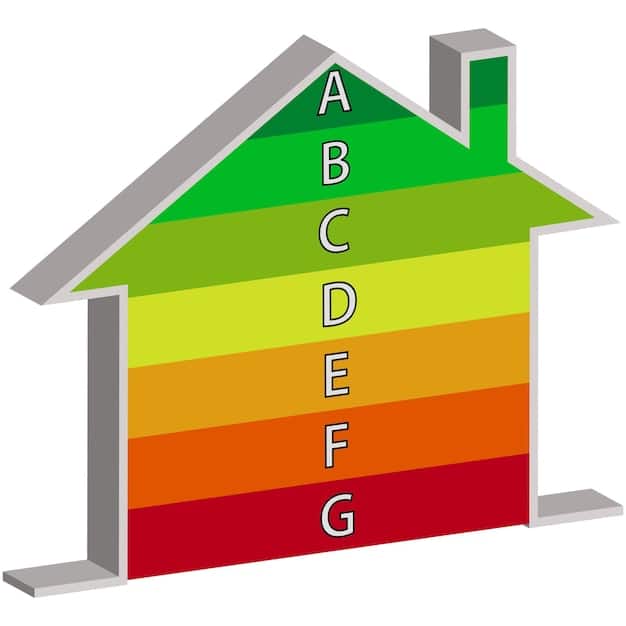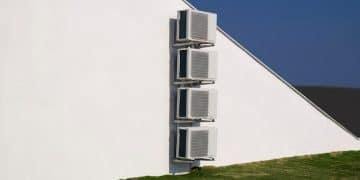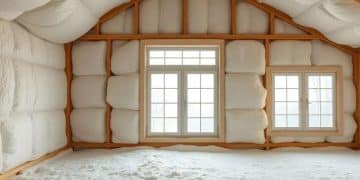Energy-Efficient Windows: Find the Right R-Value for Savings

Energy-efficient windows are crucial for maintaining a comfortable home while minimizing energy costs; the R-value, which measures a window’s insulation capability, is key to maximizing these savings, and selecting the appropriate R-value for your climate and home design is essential.
Are you looking to upgrade your windows and save money on your energy bills? Understanding the **energy-efficient windows: What R-value do you need for maximum savings?** is crucial for making the right choice, it impacts your home’s comfort and energy consumption.
Understanding Energy-Efficient Windows
Energy-efficient windows are designed to reduce heat transfer between the inside and outside of your home. This is a critical aspect of maintaining a comfortable indoor environment while minimizing energy consumption, leading to lower utility bills and a smaller carbon footprint. But what makes a window energy-efficient?
Key Components of Energy-Efficient Windows
Several factors contribute to the energy efficiency of a window. These include the glazing, frame material, and overall design. Each component plays a role in minimizing heat transfer and maximizing insulation.
- Glazing: This refers to the glass used in the window. Double- or triple-pane windows with low-E coatings are highly effective in reducing heat transfer.
- Frame Material: The material used for the window frame also influences its energy efficiency. Common materials include wood, vinyl, fiberglass, and aluminum.
- Design: The overall design of the window, including airtight seals and proper installation, is crucial for preventing drafts and air leakage.
By understanding these components, homeowners can make informed decisions when selecting energy-efficient windows. Proper installation and maintenance are also essential for ensuring optimal performance over the long term.

Benefits of Energy-Efficient Windows
Investing in energy-efficient windows offers numerous benefits, both financially and environmentally. Beyond reducing energy consumption, these windows can also enhance the comfort and value of your home.
Energy-efficient windows are a key component of a comfortable and sustainable home. By understanding their features and benefits, homeowners can make informed decisions that improve their living environment and reduce their environmental impact.
What is R-Value and Why Does It Matter?
The R-value is a measure of thermal resistance, indicating how well a material resists the flow of heat. In the context of windows, a higher R-value means better insulation and reduced heat transfer through the window.
Understanding R-Value
The R-value is expressed as a numerical value, with higher numbers indicating greater insulating ability. This value is crucial for assessing the energy efficiency of windows and determining their suitability for different climates.
Understanding R-value is fundamental for selecting energy-efficient windows. By choosing windows with appropriate R-values, homeowners can optimize their home’s energy performance and reduce their energy costs.
How R-Value Affects Energy Efficiency
The R-value directly impacts the amount of heat that can pass through a window. In colder climates, a higher R-value helps to keep heat inside the home, reducing the need for heating. In warmer climates, it helps to keep heat out, reducing the need for air conditioning.
- Heat Retention: Windows with higher R-values retain heat more effectively, reducing heating costs in winter.
- Heat Rejection: These windows also reject heat more efficiently, reducing cooling costs in summer.
- Overall Comfort: By minimizing heat transfer, windows with appropriate R-values contribute to a more comfortable indoor environment.
The R-value of a window is a critical factor in determining its energy efficiency. Selecting windows with appropriate R-values can significantly impact your home’s energy consumption and overall comfort.

Factors Influencing R-Value
Several factors influence the R-value of a window. These include the type of glazing, the presence of gas fills, and the frame material. Understanding these factors can help homeowners choose windows with optimal R-values for their specific needs.
The R-value is a critical measure of a window’s insulation capability, directly impacting its energy efficiency. By understanding the factors that influence R-value, homeowners can make informed decisions that enhance their home’s energy performance and comfort.
Choosing the Right R-Value for Your Climate
The ideal R-value for your windows depends largely on your climate zone. Different regions have different heating and cooling needs, which require different levels of insulation.
Climate Zones and R-Value Recommendations
Climate zones are geographical areas with similar climate conditions. These zones are used to determine the appropriate insulation levels for buildings, including windows.
Selecting the right R-value for your climate is essential for optimizing energy efficiency. By considering your region’s specific climate conditions, you can choose windows that provide the best balance of insulation and energy savings.
- Mild Climates: In milder climates, windows with moderate R-values may be sufficient.
- Cold Climates: In colder climates, windows with higher R-values are necessary to prevent heat loss.
- Hot Climates: In hotter climates, windows with higher R-values can help to keep heat out and reduce cooling costs.
Regional Considerations
In addition to climate zones, regional factors such as sunlight exposure and wind patterns can also influence the ideal R-value for your windows. Homes in areas with high sunlight exposure may benefit from windows with special coatings to reduce heat gain.
Choosing the right R-value for your climate is a crucial step in optimizing your home’s energy efficiency. By considering both climate zones and regional factors, you can select windows that provide the best performance and long-term savings.
Window Materials and Their R-Values
The material used for the window frame significantly impacts its R-value. Different materials offer varying levels of insulation, affecting the overall energy efficiency of the window.
Comparing Window Frame Materials
Common window frame materials include wood, vinyl, fiberglass, and aluminum. Each material has its own advantages and disadvantages in terms of insulation, durability, and cost.
The choice of window frame material is a significant factor in determining the overall energy efficiency of the window. By comparing the R-values of different materials, homeowners can select windows that best meet their needs and budget.
- Wood: Wood frames offer good insulation but require regular maintenance.
- Vinyl: Vinyl frames are low-maintenance and provide decent insulation.
- Fiberglass: Fiberglass frames are durable and offer excellent insulation.
- Aluminum: Aluminum frames are strong but conduct heat easily, making them less energy-efficient.
Enhancing R-Value with Frame Design
Even with less insulating materials like aluminum, innovative frame designs can enhance the R-value. Thermal breaks and other design features can reduce heat transfer and improve energy efficiency.
Window materials play a crucial role in determining R-value. By understanding the insulating properties of different frame materials and design features, homeowners can make informed decisions that improve their home’s energy performance.
Installation and Maintenance for Optimal R-Value
Proper installation and maintenance are essential for ensuring that your windows perform at their optimal R-value. Poor installation can lead to air leakage and reduced energy efficiency, even with high-quality windows.
Importance of Professional Installation
Professional installation ensures that windows are properly sealed and aligned, preventing drafts and air leakage. A qualified installer can also identify potential issues and address them before they compromise the window’s performance.
Professional installation is a critical step in ensuring that your windows perform at their optimal R-value. By hiring a qualified installer, you can avoid common issues and maximize the energy efficiency of your windows.
- Proper Sealing: Ensures that windows are airtight and prevent drafts.
- Correct Alignment: Prevents stress on the window frame and ensures smooth operation.
- Addressing Issues: Identifies and resolves potential problems before they impact performance.
Regular Maintenance Tips
Regular maintenance can help to prolong the life of your windows and maintain their energy efficiency. This includes cleaning the glass and frames, inspecting seals for damage, and addressing any issues promptly.
Installation and maintenance are critical for ensuring that windows perform at their optimal R-value. By following these guidelines, homeowners can maximize the energy efficiency of their windows and enjoy long-term savings.
Energy-efficient windows are a valuable investment for any homeowner looking to reduce energy costs and improve their home’s comfort. By understanding R-values, selecting the right materials, and ensuring proper installation and maintenance, you can maximize the benefits of energy-efficient windows.
Calculating Long-Term Savings with Energy-Efficient Windows
Understanding the potential long-term savings from energy-efficient windows can help homeowners make informed investment decisions. These savings can be substantial, especially in climates with significant heating and cooling demands.
Estimating Energy Savings
Energy savings can be estimated by considering factors such as the R-value of the windows, the climate zone, and the size of the home. Online calculators and energy audits can provide more precise estimates.
Calculating long-term savings is a key step in evaluating the investment potential of energy-efficient windows. By estimating these savings, homeowners can make informed decisions that maximize their return on investment.
- Online Calculators: Use online tools to estimate potential savings based on specific factors.
- Energy Audits: Schedule an energy audit to assess your home’s energy performance and identify areas for improvement.
- Climate Zone Data: Utilize climate zone data to understand the heating and cooling demands in your region.
Return on Investment (ROI)
The return on investment (ROI) for energy-efficient windows can be calculated by comparing the cost of the windows to the estimated energy savings over their lifespan. Factors such as government incentives and tax credits can also impact the ROI.
Calculating long-term savings is essential for evaluating the investment potential of energy-efficient windows. By understanding the potential savings and ROI, homeowners can make informed decisions that improve their home’s energy efficiency and save money over the long term.
| Key Point | Brief Description |
|---|---|
| 💡R-Value Importance | Higher R-value means better insulation, reducing heat transfer. |
| 🌡️Climate Zones | Different climates require different R-values for optimal efficiency. |
| 🔨Installation Matters | Proper installation prevents air leakage and maximizes window performance. |
| 💰Long-Term Savings | Energy-efficient windows can lead to significant savings over time. |
Frequently Asked Questions
▼
The ideal R-value varies by climate, but generally, aim for R-3 to R-7 in colder regions and R-2 or higher in milder climates to maximize energy efficiency.
▼
Double or triple-pane windows with low-E coatings and gas fills significantly increase R-value by reducing heat transfer, improving insulation performance.
▼
Fiberglass and wood frames generally offer better insulation compared to aluminum, with vinyl providing a balance of cost-effectiveness and decent R-value.
▼
Yes, adding window films, thermal curtains, or storm windows can help improve the insulation and R-value of existing windows, reducing heat loss.
▼
Professional installation ensures proper sealing and alignment, preventing air leaks and drafts, which is crucial for maintaining the window’s intended R-value and energy efficiency.
Conclusion
In summary, choosing the right R-value for your energy-efficient windows is essential for maximizing energy savings and enhancing your home’s comfort. By considering your climate, window materials, and installation practices, you can make informed decisions that provide long-term benefits.





